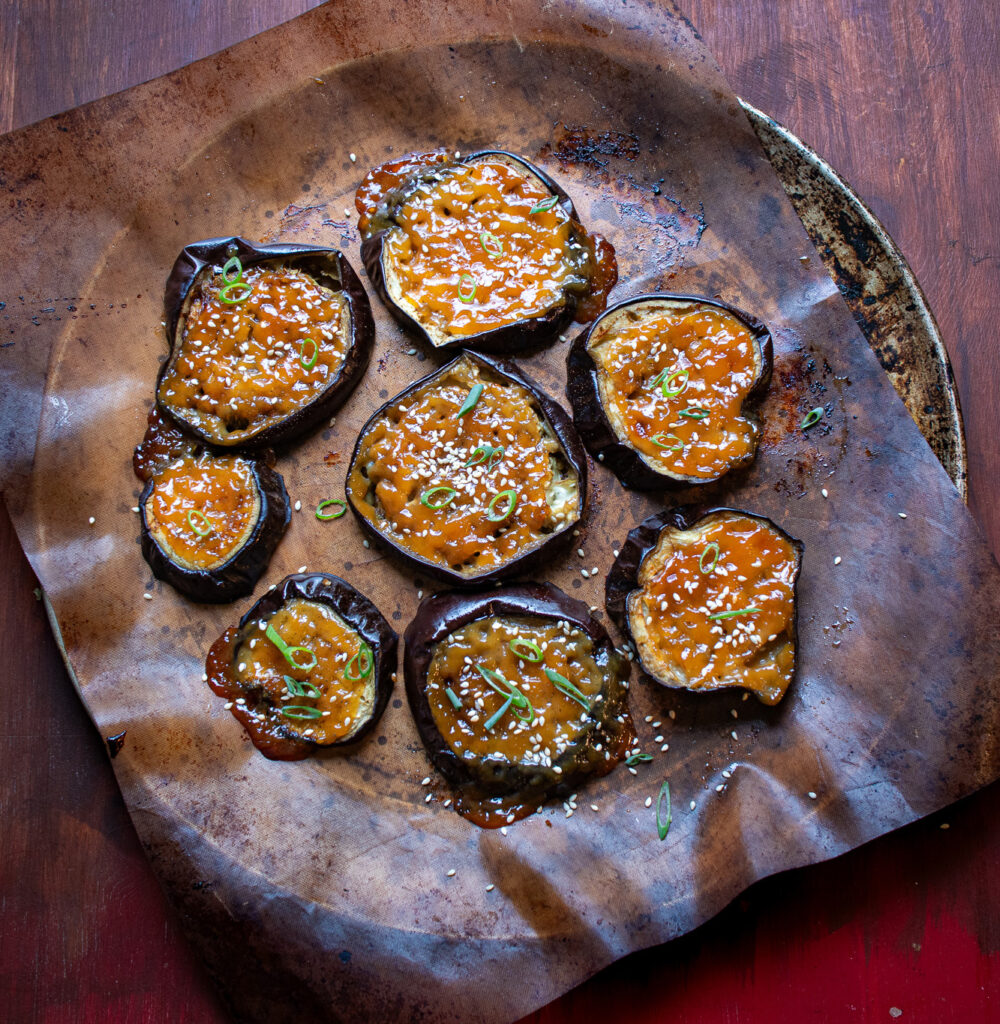
Growing up, it took me a while to warm up to eggplant.
As a kid, I just wasn’t into the taste and texture. Tastes change and evolve, and over the years – especially in my travels – I discovered many dishes with eggplant which taught me to love the vegetable: Italian-American Eggplant Parmesan and Italian Parmigiana di Melanzane, Chinese-American Garlic Eggplant, North Indian Bengan Bhartha, Persian (Iranian) Mirza Ghasemi, and Middle Eastern (Levantine) Baba Ganoush. (I also learned that eggplant was known as aubergine in other parts of the English-speaking world.)
The first time I had Japanese Nasu Dengaku was only a decade ago.
I was immediately taken by the rich, smoky flavors of roasted eggplant coupled with the sweet & salty miso glaze. A friend of mine shared a recipe; I tried it out and absolutely loved it. I developed my own recipe and made it regularly for friends, family, and dinner parties.
On my second trip to Japan, I drafted a list of recipes for The Lotus and the Artichoke – JAPAN cookbook.
It was clear I’d include Nasu Dengaku. During the early recipe development and photography for the book, I set out to refine my recipe further. After several sessions of experimentation, I settled on this version. (For what it’s worth, I’m not thrilled with the photo, but in a rare case of overcoming Masterpiece Syndrome, I decided to let go and use it for the cookbook and website, rather than shoot it a third – or fourth – time hoping for a better studio photo.)
Nasu Dengaku is an excellent dish for getting others (including young eaters) into aubergine.
The salting, rinsing, and then roasting of the eggplants draws out most of the characteristic bitterness. The sweet miso glaze rounds out the rest. Many will tell you that the eggplants in stores now are less bitter than a couple decades ago. While this may be true, I still prefer to salt and rinse the vegetable slices beforehand. Admittedly, much my reasoning is nostalgic – When I was first getting into cooking as a teen, my mother had taught me the trick with eggplant for baked casseroles and lasagna.
Tweak this recipe to your heart’s content; it’s very versatile and forgiving. Sake is not crucial, but is a nice touch. The same goes for mirin. You can also use white miso paste instead of red. I would emphasize that you don’t want to burn the glaze, but truth be told, if you follow the recipe and keep an eye on your oven, I’m sure you’ll be just fine.
By the way, there’s similar recipe in the dessert section of The Lotus and the Artichoke – JAPAN for Ichijiku Dengaku, roasted miso-glazed figs. It’s a lot of fun, too!
Nasu Dengaku
roasted miso-glazed eggplant (aubergine)
serves 2 to 3 / time 45 min
recipe from The Lotus and the Artichoke – JAPAN
(Rezept auf Deutsch unten)
- 3–4 medium (300 g) long, thin Asian/Japanese eggplants (aubergines)
or 1 medium (300 g) eggplant (aubergine) - 2 Tbs (45 g) red miso paste
- 2 1/2 Tbs (30 g) raw sugar
- 2 Tbs vegetable oil
- 1 Tbs mirin optional
- 2 tsp sake optional
- 2 Tbs sesame oil
- 2–3 tsp sesame seeds lightly roasted
- Preheat oven to 400° F / 200° C / level 6.
- Cut long, thin eggplants (aubergines) in half lengthwise or into round slices about 1/2 in (12 mm) thick. If using a larger eggplant, cut it into round slices or lengthwise slabs about 1/2 in (12 mm) thick.
- Soak eggplant halves or slices in a large bowl of cold water for 10 min.
- Heat a small pot on medium low heat. Add miso paste, sugar, vegetable oil, mirin, and sake (if using). Whisk until smooth and sugar is melted, 2–3 min. Remove from heat. Set aside.
- Drain, rinse, and dry eggplant halves or slices.
- Brush eggplant halves or slices on both sides with sesame oil and arrange them on a baking tray lined with baking paper or a silicone baking mat, facing down if using halves.
- Transfer to the oven and bake on the top rack until tender, 25–40 min. The flesh should be browned and skins shriveled. If the slices or halves are thick, the baking time may need to be increased.
- Flip the eggplant halves or slices. Using a spoon or brush, generously coat the flesh with miso glaze.
- Bake until the glaze is bubbly and caramelized, about 5–8 min. Be careful not to burn the glaze!
- Remove from the oven. Let cool for 10 min.
- Garnish with sesame seeds and serve.
Nasu Dengaku
geröstete Aubergine mit Misoglasur
2 bis 3 Portionen / Dauer 45 Min.
Rezept aus The Lotus and the Artichoke – JAPAN
- 3–4 mittelgroße (300 g) japanische Auberginen (lang, dünn)
oder 1 mittelgroße (300 g) Aubergine - 2 EL (45 g) rote Misopaste
- 2 1/2 EL (30 g) Rohzucker
- 2 EL Pflanzenöl
- 1 EL Mirin wenn gewünscht
- 2 TL Sake wenn gewünscht
- 2 EL Sesamöl
- 2–3 TL Sesamsamen leicht geröstet
- Den Ofen auf 200° C / Stufe 6 vorheizen.
- Lange, dünne Auberginen in runde Scheiben von etwa 12 mm Dicke schneiden oder der Länge nach halbieren. Größere Auberginen in runde Scheiben oder längs in ca. 12 mm dicke Platten schneiden.
- Auberginenhälften oder -scheiben 10 Min. in einer großen Schüssel mit kaltem Wasser einweichen.
- Einen kleinen Topf auf mittlerer bis niedriger Flamme erhitzen. Misopaste, Zucker, Pflanzenöl, Mirin und Sake (falls verwendet) hineingeben. Aufkochen lassen und 2 bis 3 Min. verrühren, bis der Zucker geschmolzen ist und die Mischung glatt wird. Vom Herd nehmen. Beiseite stellen.
- Auberginenhälften oder -scheiben abgießen, abspülen und trocknen.
- Auberginenhälften oder -scheiben auf beiden Seiten mit Sesamöl bepinseln und auf ein mit Backpapier oder Silikonbackmatte ausgelegtes Backblech legen – Hälften mit der Schnittfläche nach unten.
- In den vorgeheizten Ofen geben und auf der obersten Schiene 25 bis 40 Min. rösten, bis das Fruchtfleisch weich und gebräunt und die Haut verschrumpelt ist. Wenn die Scheiben oder Hälften dick sind, muss die Backzeit eventuell verlängert werden.
- Die Auberginenhälften oder -scheiben auf dem Blech wenden. Das Fruchtfleisch mit einem Löffel oder Pinsel großzügig mit Misoglasur bestreichen.
- Auf der obersten Schiene noch 5 bis 8 Min. backen, bis die Misoglasur blubbert und karamellisiert ist. Aufpassen, dass die Glasur nicht verbrennt!
- Aus dem Ofen nehmen. 10 Min. abkühlen lassen.
- Mit gerösteten Sesamsamen garnieren und servieren.


